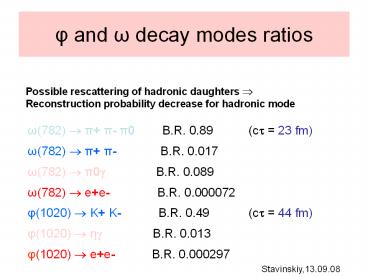f and ? decay modes ratios - PowerPoint PPT Presentation
Title:
f and ? decay modes ratios
Description:
... and lower pT using new methods, i.e. no kaon ID and single kaon ID methods. The three independent kaon analyses are consistent with each other. d Au. 0-20% f. p p ... – PowerPoint PPT presentation
Number of Views:217
Avg rating:3.0/5.0
Title: f and ? decay modes ratios
1
f and ? decay modes ratios
Possible rescattering of hadronic daughters
? Reconstruction probability decrease for
hadronic mode
?(782) ? p p- p0 B.R. 0.89 (c? 23
fm) ?(782) ? p p- B.R. 0.017
?(782) ? p0? B.R. 0.089 ?(782)
? ee- B.R. 0.000072 f(1020) ? K
K- B.R. 0.49 (c? 44 fm) f(1020) ?
?? B.R. 0.013 f(1020) ? ee-
B.R. 0.000297
Stavinskiy,13.09.08
2
Decay modes ratios- new source of information
t
hadrons
with without QGP
quarksgluons
3
Model
l0ctß/v(1-ß2) (ß1/3 for this
estimate) 15fm(for f)8fm(for ?)
li2fm for any hadron 1fm for any pair
of hadrons
li
l0
?
?
f
?
l
hadronization
Kinetic freeze-out
4
Results
- Upper line lepton mode
Splitting two hadron and hadron-photon modes
l -decay products trajectory length within
matter
f
ß 1/3
?
Stavinskiy,13.09.08
l,fm
5
PHENIX
STAR
AuAu
vsNN 200 GeV
?? p0?
f? ee-
Is it really possible measurements?
6
Extended f ? KK- analysis
Consistency between f ? KK- and f ?ee-
f
dAu
0-20
M.B.
pp
- f?KK- measurements have been extended to both
higher and lower pT using new methods, i.e. no
kaon ID and single kaon ID methods. - The three independent kaon analyses are
consistent with each other.
In pp, spectra of ee- and KK- show reasonable
agreement!
7
Low pT mesons tend to decay inside the hot/dense
matter
f
f
Low pT
High pT
Thus, pT-dependent information is essential for
comparison.
8
Spectra comparison between f?ee- and f? KK-
AuAu
M.B.
40-92
20-40
Errors are too large to make any clear statement
about the comparison of spectra for f ? ee- and
f ? KK-.
9
- F ? information early stages of the collision
- F ? different production for hadronic and
leptonic channels - K ? time between chemical and kinetic freeze-out
S. Pal et al., Nucl.Phys. A707 (2002) 525-539
- If resonance decays before kinetic freeze-out ?
not reconstructed due to rescattering of
daughters - K0 (c? 4 fm) survival probability ? time
between chemical and kinetic freeze-out, source
size and pT of K0 - Chemical freeze-out ? elastic interactions pK ?
K0? pK regenerate K0(892) until kinetic
freeze-out - K0/K may reveal time between chemical and
kinetic freeze-out
Chemical freeze-out
Kinetic freeze-out
P. Fachini BNL,SQM2007
10
K ? Ratios
Chemical freeze-out
Kinetic freeze-out
Chemical Kinetic freeze-out
- K/K- ? pp ratio reproduced by thermal model at
chemical freeze-out ? AuAu reproduced by thermal
model at kinetic freeze-out
11
Y. Nakamiya Hiroshima University, Japan for the
PHENIX collaboration QM 2008, India
- Branching ratio between ee- and KK- may be
sensitive to mass modification, since Mphi is
approximately 2 ? MK. - -gt Compare yields of f?ee- and f? KK-
12
F Production ? KK- and ee-
ee-
KK-
- The leptonic channel yield is a little higher
than hadronic channel - More accurate measurement is required to confirm
whether there is branch ratio modification
13
What is the difference?
- Modes absorbtion vs Mass modification
- Standard mesons vs modified mesons
- f?KK f???
- Modes absorbtion vs K/K ratio
- Reference- Lepton modes vs thermal model
- Hadronization stage vs equilibrium stage
- Modes absorbtion vs both other approaches
- Internal cross-check - 3 modes
Stavinskiy,ITEP,13.09.08
14
Real sMN in matter can differ from that in
free space
- ? photoproducton on nuclear targets (ELSA)
- M.Kotulla et al.,
ArXiv nucl-ex/08020980 - s?N 70 mb (in nuclear medium, 0.5 lt P lt1.6
GeV/c) - s?N 25 mb (in free space - the model
calculations)
- ? photoproducton on nuclear targets
- T.Ishikawa et al.,
Phys.Lett.B608,215,(2005) - sfN 35 14 mb (in nuclear medium)
- sfN 10 mb (in free space)
- f-puzzle
photoproducton on nuclear targets
15
To Do
- To make calculations for the effect of interest
within realistic model - To create algorithm for photonic modes
identification in AA interactions - To check this algorithm for ALICECBM conditions
with realistic simulations
Stavinskiy,ITEP,13.09.08
16
Extra slides
17
(No Transcript)
18
Formulas
Stavinskiy,ITEP,10.06.08
19
Electron, hadron and photon in PHENIX
f/w ? ee-
- PHENIX acceptance
- -0.35 lt ? lt 0.35
- 2 x 90in azimuthal angle for two arms
- Event selection
- BBC
- Electron ID
- RICH
- EMCal
- photon ID
- EMCal
- Hadron ID
- TOF
- EMCal-TOF
w ? pp-p0, p0g
f ? KK-
20
(No Transcript)
21
Why ? ?(common part)
- The????meson was proposed in the middle of
80(Koch,Muller,Rafelski PR142,ShorPRL54) as one
of the most promising QGP messengers because of
the following reasons - an enhancement of ??meson, as well as other
strange hadrons in QGP phase - ??interaction cross section is small and ??will
keep information about the early hot and dense
phase - ???meson spectrum is not distorted by feeddown
from resonance decays - strangeness local conservation for ??? ???
Stavinskiy,ITEP,9.04.08

